1875-S BF-SP-2 |
|
|
Obverse 1  Die chip below the hand on left side of pole
Horizontal raised die polish marks, some heavy, can be seen under LIBERTY on the shield.
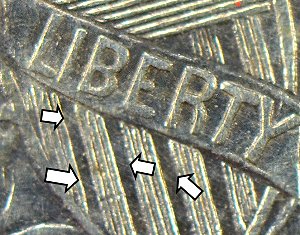 Die polish lines
Two raised lumps appear in the void next to the lower right side the shield.
 Two lumps right of shield Date Position: M 3.5, 0.45 mm |
Reverse A 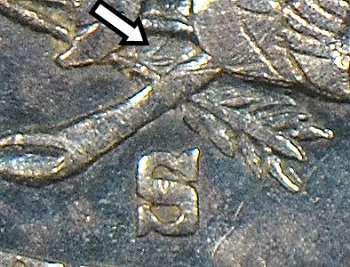
Diagonal die line The TS in CENTS is weak and there are two die defects due to excessive die polishing before striking these coins. The upper left serif of the T and the lower left serif of the S are separated from the rest of their respective letters. The die lapping also weakened the nearby denticles. 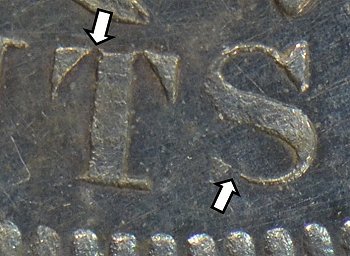
Separated serifs in "TS" The middle olive leaves (above EN in CENTS) are disconnected from the stem as a result of over-polishing the die. 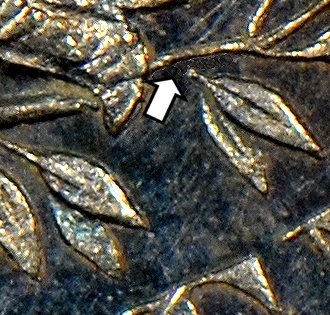
Disconnected leaves |
|
Comments: This is the second use of this obverse die. This is the first use of this reverse die. |
|
|
Scarcity: Very rare, perhaps a half dozen known, most impaired. Rarity rating: R-7. |
|
Additional Commentary
Because this die pairing was also used later for circulation strikes, more discussion is needed to help differentiate this issue from a well-struck and somewhat proof-like circulation issue.
Because the branch mints were not normally in the business of making proofs or special strikes, and all dies were made at the Philadelphia mint and shipped to the branch mints, the dies on hand for these presentation pieces were nothing special. In the case of the 1875-S special or specimen strikes, the dies used had some definite die markers which appear on the coins. These markers help make the identification of the dies used to strike these coins very straightforward.
The dies used to strike the special strikes were later used to produce coins for circulation. Therefore, the diagnostics of the dies are not sufficient alone to determine that a coin is a a Specimen or Special Strike. For example, the coins must be very well struck, have highly reflective surfaces, clearly separated denticles, and possess square rims. Several numismatic specialty references are available to assist a collector in determining if a coin may be a proof or special strike issue.
The following description will highlight both the diagnostics of the dies, along with other evidence which must be present on a coin to be even considered a possible rare specimen strike.
General Diagnostics
Detail
The 1875-S special strikes have a level of detail from the striking process that is not present on circulation strikes, even if the circulation coins are well-struck.
In addition to highly reflective fields, key places to look are the high points of the coin:
- The letters of LIBERTY on the shield will be extremely well struck-up and have the appearance of being squared
- Liberty s head will have a strong level of detail in the hair and facial features
- The eagle s central breast feathers, neck, and wings will show extraordinary detail, even on the highest points.
Some weakness will be found on the denticles on the lower reverse. This is expected and not due to strike. It is a result of the excessive die polishing that occurred before the dies were used to strike the coins.


Three-dimensionality and exceptional details
Other artifacts not present on circulation strikes, but found on proofs or specimen strikes include:
Border and Edge
The 1875-S special strikes will have a border that is wider than a typical circulation strike. A special strike will also have a squared edge and distinctly separated denticles. The rims may also have a raised line along the edge, referred to as a wire rim.
Many well-struck circulation strikes, including those struck by these dies, have a partial wire or raised rim. On circulation strikes, however, the rim on the opposite side will be rounded or beveled.
Dished or concave-looking fields
Because of the way these special strike coins were struck, the fields surrounding the devices near the rims will appear to be concave. This concavity also enhances the appearance of the mirrored fields.


Planchet Preparation Lines
These lines occur when the blank planchet has been burnished or polished before striking. Planchet striations are not always visible on branch mint proofs and special strikes due to improper handling or cleaning of the coins, however.
Lines on a coin resulting from planchet preparation are different from those resulting from die polishing. Polishing the die leaves shallow scratches in the die’s fields which result in raised lines on the struck coin. Planchet preparation is the polishing of the planchet prior to striking, leaving striations on the unstruck planchet. The planchet is then struck with the dies and the striations are flattened as a result of the striking. As such, the striations have no relief. These striation lines can also appear to extend into the devices. Although difficult to see, the presence of these striation lines on a coin support the coin being a special strike. Planchet preparation lines are not found on circulation strikes as the planchets used for those coins were not polished before coining.
Interestingly, most of the 1875-S special strikes have an obverse with deeper mirrors than the reverse. This is likely due to the obverse side of the planchet receiving more attention during preparation than the reverse and that the planchets were then placed with a specific orientation during striking.
The horizontal pattern in the picture below and left are the parallel polishing lines from when the planchet was polished before striking.
Lint Marks
When a die is polished in the process of making proofs or special strikes, often a piece of lint from the polishing cloth is left behind on the die. When a die with lint adhered to it strikes a planchet, the coin is struck through the lint and there will be an incuse mark showing where the lint fiber was during striking. This is referred to as a lint mark.


Lint marks are fairly common with proofs and special strikes, but not so with circulation strikes. The presence of a lint mark supports a coin’s proof or specimen status, but is not conclusive evidence.
As more proofs were struck, the number of lint marks decreased until there were none, as seen on some specimens.
The presence of a lint mark supports a coin s proof or specimen status, but is not conclusive evidence.
Dies used for Circulation Strikes
The same pair of dies used to strike the 1875-S special strikes were also used to coin regular circulation strikes. Circulation strikes from this die marriage can be found with modest effort. Some of the coins are very well struck with a partial wire rim. These circulation strikes, however, do not have the depth of strike or reflective fields found on the proofs, nor do they have the attributes described above.
Controversy
There are some collectors who doubt the existence of 1875-S branch mint proofs or special strikes entirely. However, examination of the finest known examples of the 1875-S branch mint proofs (BF-BMP-1) clearly yields coins that are special and of far superior quality to pieces struck for circulation, and on par with Philadelphia proofs. Even with the special strikes (BF-SP-2), comparison against proof-like circulation strikes still results in a clear distinction. These coins are the result of a special striking. However, without official records or other forms of contemporary verification, some choose to consider them proof-like circulation strikes.
The authors believe that the branch mint proof coins (BF-BMP-1) were special coins struck to commemorate the new denomination and provided to dignitaries or other guests of importance. Following this, some additional examples were desired, and a few more special strikes were made (BF-SP-2), this time with a different reverse die that was aggressively polished. Following this, this second pair of dies were tendered for service making normal circulation strikes. The question is when did the special striking end and the circulation striking begin? It is an impossible question to answer as no official records are known. It remains a decision based on the coin and its similarity to an actual proof coin.
Values
There are currently only 4 coins that have been certified and graded as branch mint proofs by the two major grading services. However, it is unknown whether these 4 coins represent unique pieces or are duplicate submissions to the grading companies. Of the two finest known examples, records show a Proof-63 selling privately in 1995 for $65,000 and the Proof-64 Cameo selling at auction in 2004 for over $100,000. This coin, most likely the Roy Rauch discovery coin, is the finest known and currently resides in the Black Cat Collection. It is safe to say this coin is worth considerably more today.
For the rest of the special strikes, the sale prices are not nearly as high. Most of the rest of the known examples are impaired and often unattractive. These impaired examples have sold in the modest range of $4,000-7,000. The plate coin in this book for the BF-SP-2, is one such coin that was mishandled and lightly cleaned many years ago, but has naturally re-toned over many decades with an attractive, original-looking skin.
Another factor is that the issue is so rare as to be nearly unobtainable, and a collector can still have a "complete set" without one, lowering demand significantly. The relatively modest value of impaired branch mint special strikes is also due in part to the controversy surrounding this issue and the reluctance of collectors to pay large premiums for coins that are not universally accepted. Still, it is hard to predict what one of these is worth today, either impaired or not, as each example is different, and eye appeal is paramount.
1875-S BF-SP-2 - Obverse 1 |
1875-S BF-SP-2 - Reverse A |
 Click for full-size image |
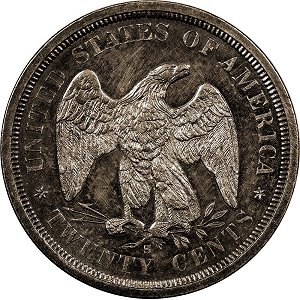 Click for full-size image |
